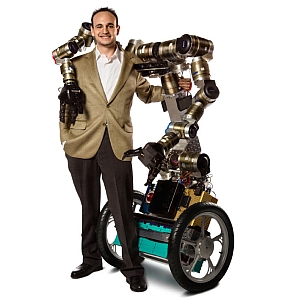A research team at Georgia Institute of Technology in Atlanta is building a robot with the ability to use objects in its environment to accomplish high-level tasks. The three-year project, being led by computer scientist Mike Stilman, is funded by a $900,000 grant from the U.S. Office of Naval Research.
“We want to understand the basic cognitive processes that allow humans to take advantage of arbitrary objects in their environments as tools,” says Stilman. “We will achieve this by designing algorithms for robots that make tasks that are impossible for a robot alone possible for a robot with tools.”
If successful, those algorithms will provide robots with capabilities like the 1980s television character MacGyver, who solved complex problems and escaped dangerous situations by using everyday objects and materials he found at hand. Stilman expects to build on his earlier work with robotic navigation among movable obstacles that enabled devices to recognize and move obstacles in the way of getting from one point to another.
“This project is challenging because there is a critical difference between moving objects out of the way and using objects to make a way,” says Stilman. The algorithms developed by the Georgia Tech team are expected to make it possible for a robot to identify an arbitrary object in a room, determine the object’s potential function, and turn that object into a simple machine that can be used to complete an action.
Underlying those functions are a basic knowledge of rigid body mechanics and simple machines for the robot to determine the mechanical force properties of an object and construct motion plans for using the object to perform high-level tasks. Some of these “MacGyver-bot” actions could include using a chair to reach an elevated object, bracing a ladder against a bookshelf, stacking boxes to climb over an obstacle, and building levers or bridges from random debris.
The researchers first plan to develop a hybrid reasoning system based on the algorithms and optimize that system with computer simulations. The team is then expected to test the software using Golem Krang — pictured at top with Stilman — a humanoid robot designed and built in Stilman’s lab to study whole-body robotic planning and control.
Collaborating with Stilman is Pat Langley, director of the Institute for the Study of Learning and Expertise in Palo Alto, California, and a pioneer in the field of machine learning, as well as Dongkyu Choi, a professor of aerospace engineering at University of Kansas.
Office of Naval Research, a funder of the project, feels Stilman’s work can be valuable as more robots work with military personnel to accomplish challenging missions. “Now that robotic systems are becoming more pervasive as teammates for warfighters in military operations,” says Paul Bello, director of the office’s cognitive science program, “we must ensure that they are both intelligent and resourceful.”
Read more:
- Wearable Sensor System Creates Real-Time Environment Maps
- Control Algorithm Developed to Fly Robot Aircraft Indoors
- Algorithms Devised to Aid Inspections of Mines on Ship Hulls
- Engineers Develop Robotic Driver-Assist Safety System
- Japanese Robot to be Adapted for Work with Humans
* * *


 RSS - Posts
RSS - Posts
[…] Resourceful Robot for High-Level Tasks in Development […]
[…] Resourceful Robot for High-Level Tasks in Development […]